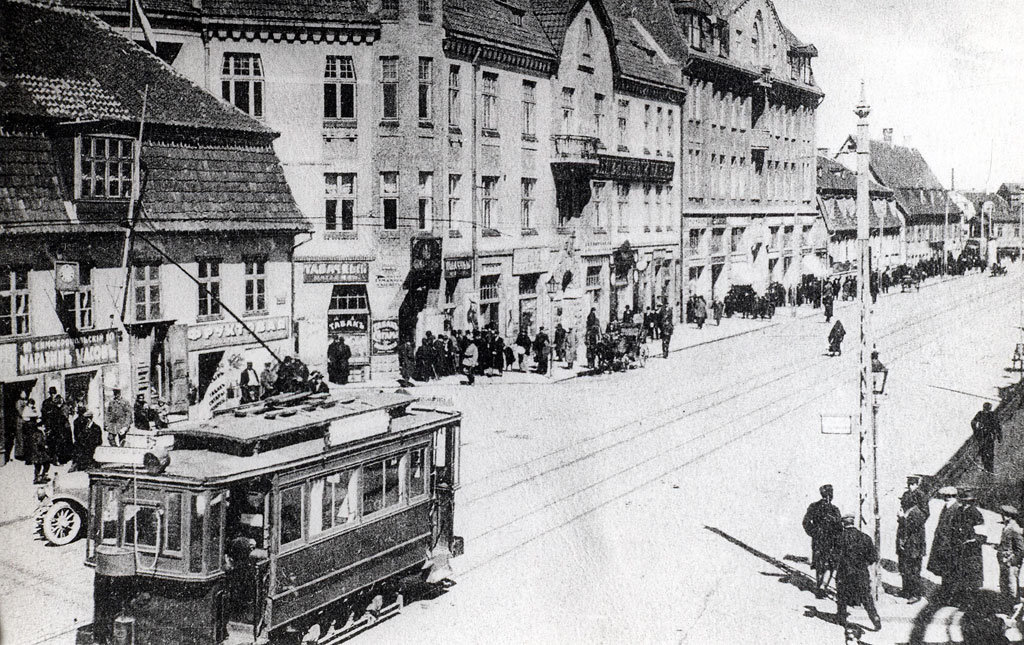|
Liepājas Tramvajs
Liepājas tramvajs is a municipal company that operates a single tram line in Liepāja, Latvia. The current double-tracked tram line has a length of . History 1899 The first electric tram line in the Baltic states was founded in Liepāja, September 26, 1899. The first nine trams used by the company were made by Herbrand (based in Köln, Germany). The first tram line was built to Karosta. 1903 In 1903 the company ordered six new trams from Herbrand. The new trams received numbers 10 to 16. 1904 Two-way tram line has been built at Liela street in the city center. 1940 After World War II the old Herbrand trams has been placed to new self-made frames. 18 March 1941 for the first time since 1899 the woman (Anna Cekuse) has become the conductor. The company starts to use tree-digit numbering, precessing tram number with 1. In 1949-1956 few trams has been built in Liepāja using the details from Kaliningrad and self-made frames. 1957 In 1957 Liepājas tramvajs h ... [...More Info...] [...Related Items...] OR: [Wikipedia] [Google] [Baidu] |
State Owned
State ownership, also called government ownership and public ownership, is the ownership of an industry, asset, or enterprise by the state or a public body representing a community, as opposed to an individual or private party. Public ownership specifically refers to industries selling goods and services to consumers and differs from public goods and government services financed out of a government's general budget. Public ownership can take place at the national, regional, local, or municipal levels of government; or can refer to non-governmental public ownership vested in autonomous public enterprises. Public ownership is one of the three major forms of property ownership, differentiated from private, collective/cooperative, and common ownership. In market-based economies, state-owned assets are often managed and operated as joint-stock corporations with a government owning all or a controlling stake of the company's shares. This form is often referred to as a state-o ... [...More Info...] [...Related Items...] OR: [Wikipedia] [Google] [Baidu] |
Conductor (transportation)
A conductor (North American English) or guard (Commonwealth English) is a train crew member responsible for operational and safety duties that do not involve actual operation of the train/locomotive. The ''conductor'' title is most common in North American railway operations, but the role is common worldwide under various job titles. In Commonwealth English, a conductor is also known as guard or train manager. The responsibilities of a conductor or guard typically include the following: * Ensuring that the train follows applicable safety rules and practices * Making sure that the train stays on schedule starting from the stations * Opening and closing power operated doors * Selling and checking tickets, and other customer service duties * Ensuring that any cars and cargo are picked up and dropped off properly * Completing en-route paperwork * Directing the train's movement while operating in reverse * Coupling or uncoupling cars * Assisting with the setting out or picking up of ... [...More Info...] [...Related Items...] OR: [Wikipedia] [Google] [Baidu] |
Rouble
The ruble (American English) or rouble (Commonwealth English) (; rus, рубль, p=rublʲ) is the currency unit of Belarus and Russia. Historically, it was the currency of the Russian Empire and of the Soviet Union. , currencies named ''ruble'' in circulation include the Belarusian ruble (BYN, Rbl) in Belarus and the Russian ruble (RUB, ₽) in Russia. Additionally, the Transnistrian ruble is used in Transnistria, an unrecognized breakaway province of Moldova. These currencies are subdivided into one hundred kopeks. No kopek is currently formally subdivided, although ''denga'' (½ kopek) and ''polushka'' (½ denga, thus ¼ kopek) were minted until the 19th century. Historically, the grivna, ruble and denga were used in Russia as measurements of weight. In 1704, as a result of monetary reforms by Peter the Great, the ruble became the first decimal currency. The silver ruble was used until 1897 and the gold ruble was used until 1917. The Soviet ruble officially replaced t ... [...More Info...] [...Related Items...] OR: [Wikipedia] [Google] [Baidu] |
Erfurt
Erfurt () is the capital and largest city in the Central German state of Thuringia. It is located in the wide valley of the Gera river (progression: ), in the southern part of the Thuringian Basin, north of the Thuringian Forest. It sits in the middle of an almost straight line of cities consisting of the six largest Thuringian cities forming the central metropolitan corridor of the state, the "Thuringian City Chain" ('' Thüringer Städtekette'') with more than 500,000 inhabitants, stretching from Eisenach in the west, via Gotha, Erfurt, Weimar and Jena, to Gera in the east. Erfurt and the city of Göttingen in southern Lower Saxony are the two cities with more than 100,000 inhabitants closest to the geographic center of Germany. Erfurt is located south-west of Leipzig, north-east of Frankfurt, south-west of Berlin and north of Munich. Erfurt's old town is one of the best preserved medieval city centres in Germany. Tourist attractions include the Merchants' Bridge (''K ... [...More Info...] [...Related Items...] OR: [Wikipedia] [Google] [Baidu] |



_front.jpg)
